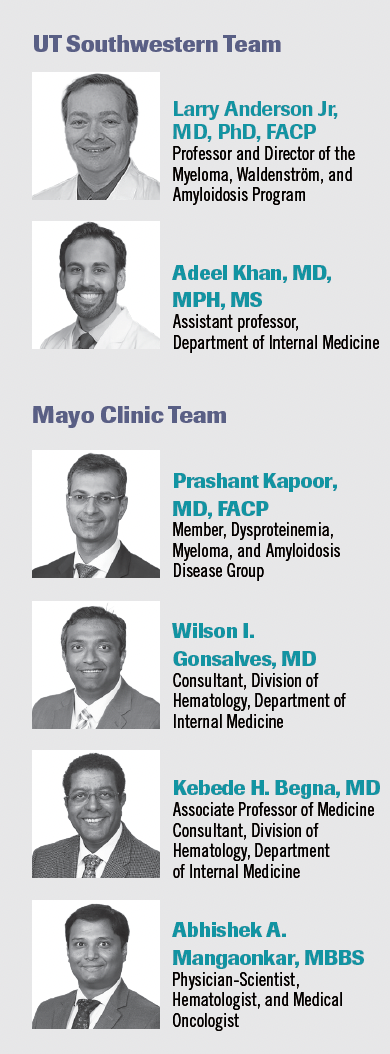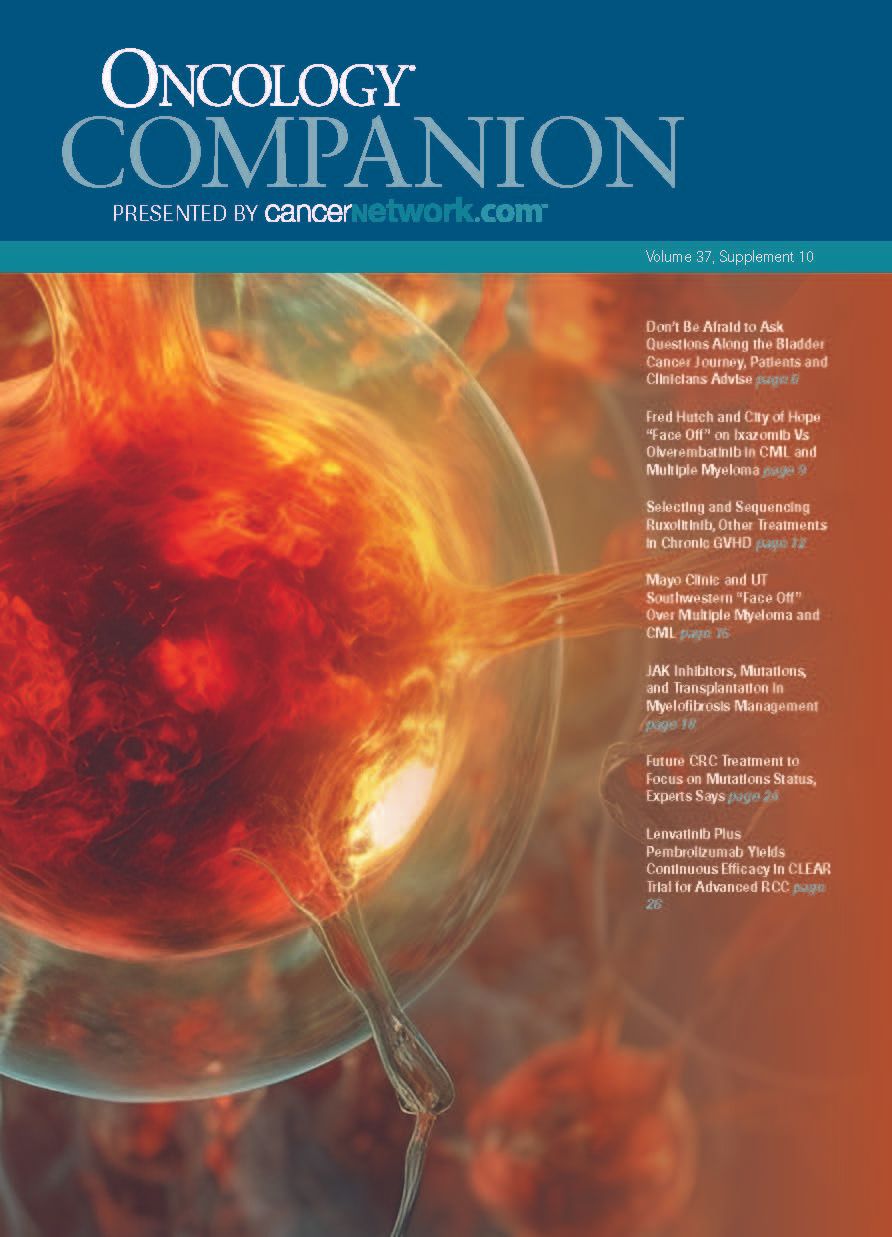Mayo Clinic and UT Southwestern “Face Off” Over Multiple Myeloma and CML
UT Southwestern and Mayo Clinic debated over current treatment options in chronic myeloid leukemia and multiple myeloma.
During a recent Face-Off program hosted by CancerNetwork, experts from the Mayo Clinic and UT Southwestern Medicine gathered to debate recent data on multiple myeloma vs chronic myeloid leukemia (CML). Each team presented data sets they believed were most important in the space. The winner was determined by a live audience who voted based on data presentation and responses to the questions the opposing team asked.
UT Southwestern and Mayo Clinic debated over current treatment options in chronic myeloid leukemia and multiple myeloma.

UT Southwestern Presents Updated MM Data
The phase 3 KarMMa-3 trial (NCT03651128) assessed idecabtagene vicleucel (Abecma; ide-cel) vs standard regimen for patients with pretreated relapsed/refractory multiple myeloma.1 The trial initially enrolled 386 patients: 254 in the ide-cel arm and 132 in a standard regimen arm. Overall, 225 patients received ide-cel and 126 patients received 1 of 5 standard regimens.
The median time from diagnosis was approximately 4 years, and the median time from previous antimyeloma therapy was approximately 7 months, with the median number of previous regimens being 3 (range, 2-4). Of note, at baseline 348 patients had disease that was refractory to immunomodulatory agents, 284 had disease that was refractory to proteasome inhibitors, and 365 had disease that was refractory to daratumumab (Darzalex). A total of 253 patients in the ide-cel arm and 89 in the standard regimen arm had triple-class refractory disease.
At the interim analysis, the median follow-up was 18.6 months. The progression-free survival (PFS) was 13.3 months (95% CI, 11.8-16.1) in the ide-cel arm vs 4.4 months (95% CI, 3.4-5.9) in the standard regimen arm (HR, 0.49; 95% CI, 0.38-0.65; P < .001). At 6 months, the PFS was 73% vs 40%, and at 12 months it was 55% vs 30% in the ide-cel and standard regimen arms, respectively.
In the ide-cel group, 71% of patients (95% CI, 66%-77%) vs 42% (95% CI, 33%-50%) in the standard regimen group had a partial response or better (OR, 3.47; 95% CI, 2.24-5.39; P < .001). In the ide-cel arm, 39% of patients had a complete response and 5% had a stringent complete response. In the ide-cel group, the median duration of response was 14.8 months (95% CI, 12.0-18.6) and 9.7 months (95% CI, 5.4-16.3) in the standard regimen group.
A total of 51 patients in the ide-cel group had minimal residual disease status within 3 months prior to the occurrence of a complete response compared with 1 patient in the standard regimen group. Overall survival data are still immature.
Adverse effects (AEs) occurred in 99% of patients in the ide-cel group and 98% in the standard regimen group. Rates of grade 3/4 AEs were observed in each arm and occurred in 93% vs 75%, respectively; grade 5 AEs occurred in 14% vs 6%, respectively.
Hematologic AEs that were most common included neutropenia (78% in the ide-cel group vs 44% in the standard regimen group), and thrombocytopenia (54% vs 29%, respectively) between both groups. Grade 3/4 infections occurred in 24% of patients in the ide-cel arm vs 18% in the standard regimen arm, with grade 5 AEs occurring in 4% vs 2%, respectively.
Serious AEs occurred in 52% of patients in the ide-cel group vs 38% in the standard regimen group. Treatment-related AEs that were grade 5 included 3% of patients in the ide-cel group and 1% in the standard regimen group.
Cytokine release syndrome (CRS) was reported in 88% of patients in the ide-cel group, of which 83% was grade 1/2. Grade 3/4 CRS occurred in 4% of patients and 1% had grade 5 CRS. Neurotoxic events, which were investigator-identified, occurred in 15% of patients. Overall, 109 patients (28%) died during the trial: 75 in the ide-cel group and 34 in the standard regimen group.
Mayo Clinic Questions UT Southwestern Data
Gonsalves: How would I apply these results to today’s patient population? I struggled with the results from the control group.
Anderson: One limitation in the design of this study is that when it was first designed this was a daratumumab-exposed population. If you look at the actual patients enrolled, 95% of the chimeric antigen receptor [CAR] T-cell group was daratumumab refractory, 93% of the standard-of-care [group] was daratumumab refractory, and the initial control was a daratumumab-based regimen. It’s set up to fail for the control group, and they later added the other options. It’s disappointing not to see a big tail on the curve for getting this as an earlier line of therapy. We were hoping to see an extended PFS, at least for a population that was having a long-term remission. We didn’t quite see [what] we expected.
Kapoor: If we compared ide-cel with teclistamab [Tecvayli], how would you incorporate them into practice, since they have similar efficacy?
Anderson: The PFS is a great advantage over the standard of care but [it is] not perfect and not necessarily much better than we would expect for the bispecifics [such as] teclistamab. The benefit of this as far as sequencing B-cell maturation antigen–directed therapies or T-cell redirection therapies, placing this in front of a bispecific, would be the data. We have retrospective data now showing that if patients have had a prior bispecific [antibody], their outcomes are going to be suboptimal with subsequent CAR T-cell [therapy], especially with ide-cel. Also, if you start out with bispecifics and then save CAR T-cell [therapy] for later, [the patient will] be on continuous therapy. [It is currently recommended on the label to administer weekly]. One of the things [patients] lack the most about the CAR T-cell therapy would be the 1-and-done [approach], and then they’re off therapy and not having to go in to do injections every week.
Mayo Clinic Discusses Arterial Occlusive Events in CML
The phase 2 PACE study (NCT01207440) was a retrospective analysis investigating arterial occlusive events (AOEs) that occurred when ponatinib (Iclusig) was used to treat patients with Philadelphia chromosome-positive acute lymphoblastic leukemia and CML.2 This trial convened an independent cardiovascular committee to review 5-year data.
The trial enrolled the patients who were resistant or intolerant to dasatinib (Sprycel) or nilotinib (Tasigna) or who had BCR::ABL1 T315Imutation despite prior tyrosine kinase inhibitor use. Patients were given ponatinib at 45 mg per day with dose reductions of 30 mg or 15 mg.
The retrospective analysis identified 181 patients (449 originally enrolled) with 455 AE records to be analyzed. Patient deaths determined not to be from disease progression, of which there were 45, were also analyzed.
The investigators found that 17% of patients had adjudicated AOEs vs 25% with nonadjudicated AOEs. Overall, 20% of patients had adjudicated serious AOEs vs 16% with nonadjudicated serious AOEs. For patients with chronic phase CML, the rate of adjudicated AOEs was 21% vs nonadjudicated AOEs of 31%.
The most common nonadjudicated AOEs occurring in more than 2% of patients were angina pectoris (6%), peripheral arterial occlusive disease (5%), myocardial infarction (4%), and coronary artery disease (3%). Arterial occlusive disease occurred in 4% of patients and was the only adjudicated AOE.
Additionally, the exposure-adjusted incidence of adjudicated AOEs was observed as 8.9 patients with events per every 100 years and serious AOEs as 8.4 patients with events per 100 patient-years. This was noted as a lower exposure-adjusted incidence of nonadjudicated AOEs of 11.3 patients with events and 9.2 patients with events per 100 patient-years. The median time to first adjudicated AOE was 14.1 months.
AOE resolution occurred in 51 patients. For the 43 patients who had 1 AOE and 35 patients with multiple AOEs, 74% and 54%, respectively, had a resolution of the events. After an AOE occurred, most patients continued treatment with ponatinib, with 9% discontinuing treatment.
For patients with adjudicated AOEs, there were higher rates of concomitant use of antihypertensive medications, platelet aggregation inhibitor medications, and antidiabetic agents vs patients who did not have AOEs. If patients had 1 or 2 risk factors, the rate of adjudicated AEs was 13% vs 29% for those with 3 or more risk factors. Of note, 80 patients did not have any risk factors at baseline, and 3% had an AOE.
Eleven adjudicated AOEs were associated with death. A history of cardiovascular events or risk factors was present in 9 patients. Reasons for death included cardiac arrest (n = 2), and 1 patient each experienced bradycardic arrest, cardiac failure, intracranial hemorrhage, worsening of congestive heart failure, superior mesenteric artery occlusion, hemorrhagic cerebral infarction, congestive heart failure, ischemic stroke, or acute anterior myocardial infarction.
UT Southwestern Ponders Validity of CML Data
Kapoor: Wouldn’t this be somewhat self-fulfilling to an extent if there is a central adjudication and there is this requirement for concordance? Obviously in the decision, there’s a lower likelihood of everyone agreeing to that. How is that considered when they’ve looked at the results?
Mangaonkar: In these types of analysis, those biases are always there. I think that it goes to the point where the focus of the study was not to show that ponatinib is safe from a vascular standpoint. We all know that it does have vascular toxicity, it has minimal changes, and we’ve shown that. The main point of the study was [to show] how much of the vascular events are truly associated with ponatinib, and how many of those AEs are just the risk profile of the patient in general. That’s why they try to separate it out because retrospective comparisons always have a limitation. If you go back to the data of the trial, there’s always a bias of what AEs you’re considering for analysis. That’s also a bias there. With all these limitations, it’s still a good analysis to help understand how we look at the risk factors for patients with ponatinib.
Final Thoughts
Both UT Southwestern and Mayo Clinic presented relevant data, and defended the research. The results were tallied, and the winner of the CML vs multiple myeloma Face-Off was Mayo Clinic.
References
- Rodriguez-Otero P, Ailawadhi S, Arnulf B, et al. Ide-cel or standard regimens in relapsed and refractory multiple myeloma. N Engl J Med. 2023;388(11):1002-1014. doi:10.1056/NEJMoa2213614
- Januzzi JL, Garasic JM, Kasner SE, et al. Retrospective analysis of arterial occlusive events in the PACE trial by an independent adjudication committee. J Hematol Oncol. 2022;15(1):1. doi:10.1186/s13045-021-01221-z
EP: 1.Team Introductions: MM Experts From UT Southwestern vs Mayo Clinic
EP: 2.Relapsed/Refractory Multiple Myeloma: The KarMMa-3 Study
EP: 3.Cross Q&A: Idecabtagene Vicleucel in Relapsed/Refractory Multiple Myeloma
EP: 4.Relapsed/Refractory Multiple Myeloma: The CARTITUDE-4 Study
EP: 5.Cross Q&A: Ciltacabtagene Autoleucel in Relapsed/Refractory Multiple Myeloma
EP: 6.Relapsed/Refractory Multiple Myeloma: The ALLIANCE A061202 Study
EP: 7.Cross Q&A: Isatuximab + Pom-Dex in Relapsed/Refractory Multiple Myeloma
EP: 8.Relapsed/Refractory Multiple Myeloma: The IKEMA Study
EP: 9.Biochemical vs Clinical Progression in Relapsed/Refractory Multiple Myeloma
EP: 10.Cross Q&A: Isa + KD in Relapsed/Refractory MM and Biochemical vs Clinical Progression
EP: 11.Mayo Clinic and UT Southwestern “Face Off” Over Multiple Myeloma and CML
